Textual Sources
The lavish layouts of the frontispieces relate directly to the importance of their content: representations of the six basic forms of government analyzed by Aristotle in the Politics and translated and reinterpreted by Oresme for medieval readers. As usual, the inscriptions furnish the internal verbal links to the text. The terms chosen for Figures 46 and 48 are Tyrannie, Olygarchie , and Democracie , the three forms of bad government. For the three good forms of government in Figures 47 and 49, the inscriptions read Royaume, Aristocracie , and Tymocracie . In B Oresme's first instruction to the reader that follows his short prologue explains the importance of these terms to the reader's understandings of Aristotle's concepts: "Item, par especial cest livre ne peut bien estre entendu en pluseurs lieus sans savoir la signification de ces .iiii. mos: aristocracie, commune policie, democracie, olygarchie . Et ces mos sunt apropriés a ceste science" (Item, this book in particular cannot be understood in several places without knowing the meaning of these four words: aristocracy, polity, democracy, oligarchy . These words are appropriate to this field of learning).[4]
Oresme's insistence on the definition of the four generic terms indicates that in an Aristotelian context they were unfamiliar to his audience. Indeed, the words tymocracie (a synonym for commune policie ), aristocracie, democracie , and olygarchie are neologisms introduced into French in Oresme's translation. The inscriptions thus correspond to Oresme's verbal explications in the text and their reinforcement in his glosses, commentaries, glossary of difficult words, and index of noteworthy subjects. Their visual representations function as analogues to the verbal definitions of these important concepts.
Also included in B , Oresme's unique second instruction to the reader spells out his reasons for featuring the six forms of government in the bifolio frontispiece:
Et donques ces .vi. policies sont principals, et sont aussi comme les elemenz et les principes de toutes autres. Et pour ce sont yci au commencement du livre pourtraittes et figurées. Et sont trois bonnes, c'est à savoir royaume, aristocracie et tymocracie. Et trois autres qui sont transgressions ou corruptions des bonnes, c'est à savoir tyrannie, olygarchie et democracie.[5]
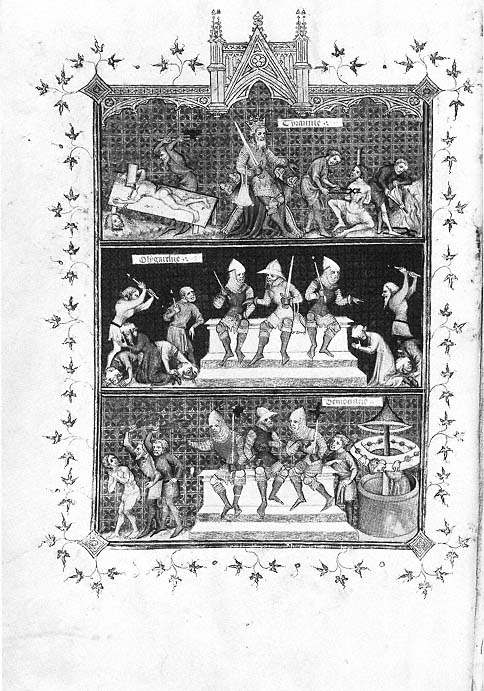
Figure 46
From top : Tyrannie, Olygarchie, Democracie. Les politiques d'Aristote, MS B.
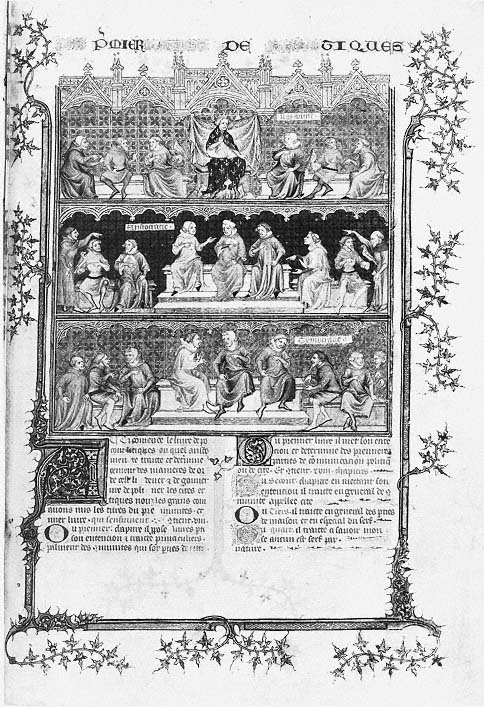
Figure 47
From top : R oyaume, Aristocracie, Tymocracie. Les politiques d'Aristote, MS B.
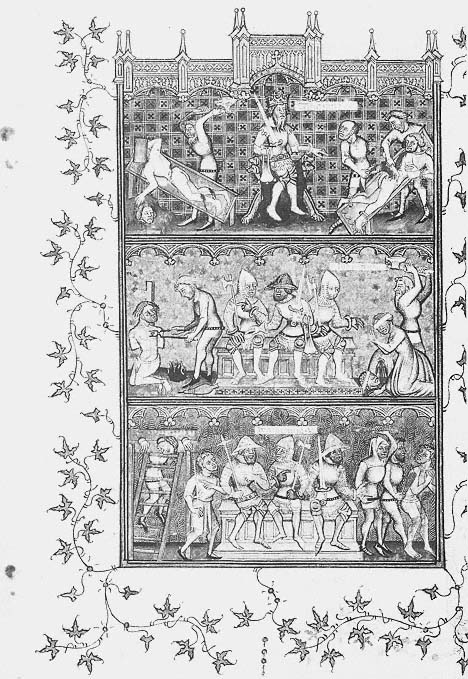
Figure 48
From top: Tyrannie, Olygarchie, Democracie. Les politiques d'Aristote, MS D.
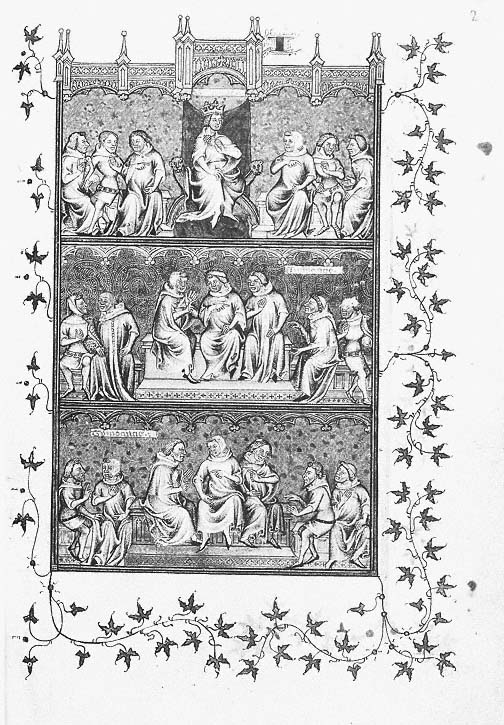
Figure 49
From top : Royaume, Aristocracie, Tymocracie. Les politiques d'Aristote, MS D.
Oresme further informs the reader that the definitions of these six terms are located in the glossaries of difficult words placed at the end of both the Ethiques and the Politiques . Oresme may have thought that such reminders were necessary, since the frontispiece occurs at the beginning of Book I of the Politiques , whereas the six forms are not systematically discussed until Book III. This separation, which contradicts the normal procedure of closely connecting the illustration with the text of the book it introduces, again shows the importance that Oresme attached to his readers' understanding of Aristotle's generic terminology.
How does Oresme define these terms in the glossary? Among the good forms, Royaume does not appear as a separate entry but is included in the definition of Monarchie: "Monarchie est la policie ou le princey que tient un seul. Et sunt .ii. especes generales de monarchie; une est royalme et l'autre est tyrannie" (Monarchy is the form of government in which one person holds power. There are two general types of monarchy: one is kingship and the other is tyranny).[6] Aristocracie is, however, accorded a separate entry: "Aristocracie est une espece de policie selon laquele ou en laquele un petit nombre de personnes bons et vaillans tiennent le princey et ont domination sus la communité et entendent a gouverner au profit commun" (Aristocracy is a type of government according to which, or in which, a small number of good and excellent people hold power and rule over the community and intend to govern for the common good).[7] The third of the good regimes, Tymocracie , is found under its synonym, Commune policie: "Commune policie est la ou une grande multitude tient le princey au profit publique; aussi comme en aristocracie un petit nombre tient le princey, et en royalme un seul le tient et tout au profit publique" (Timocracy is that [form] in which a large number holds power for the public good; as in aristocracy, a small number holds the power, and in kingship, only one holds it, all for the public good).[8]
As for the bad regimes, Tyrannie is defined succinctly as "princey ou policie ou domination ou fait de tyrant" (power, form of government, rule, or act of a tyrant).[9] A more elaborate characterization occurs under the word Tyrant : "Premierement, ce est un seul qui tient le princey et la monarchie a son propre profit et contre le bien publique" (First, it is one person who holds the power and monarchy for his benefit and contrary to the public good).[10]Olygarchie , the second bad form, is described as follows: "Olygarchie est une des .vi. especes generales de policie mises en le .viii.e et ou .ix.e chapitre du tiers livre. Et est la ou gens riches et puissans, qui sunt en petit nombre, tiennent le princey et gouvernement a leur propre profit et contre le profit publique" (Oligarchy is one of the six generic types of government located in the eighth and ninth chapters of the third book. And it is a regime in which a small number of powerful and rich people hold the power and government for their benefit and contrary to the public welfare).[11] The last of the corrupt regimes is Democratie: "Democratie est une espece de policie en laquele la multitude populaire tient le princey a leur profit. Et ne est pas bonne policie" (Democracy is a kind of government in which the popular multitude holds the power [of offices] for their own benefit. And it is not a good system).[12]
A diagram that appears in Chapter 10 of Book II of the Politiques (Fig. 50) reinforces Oresme's verbal distinctions among the three good and three bad forms
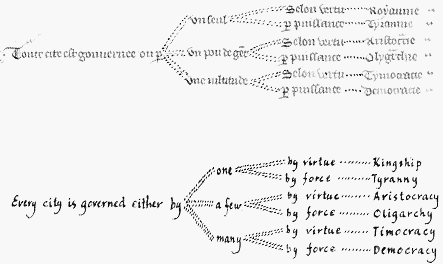
Figure 50
Diagram of The Three Good and the Three Bad Systems of Government. Les politiques
d'Aristote, MS D.
in the glossary and second instruction. Following the procedure of similar figures in his scientific translations such as the Traitié de l'espere , this diagram clarifies the distinction between forms in terms of the numbers of people who rule and their ethical and moral goals. Thus, the inscriptions and the second and first instructions lead the reader to generic definitions and classifications of basic terms and concepts. Oresme's verbal directions compress and summarize ideas that occur in parts of the text physically separated from the frontispieces.